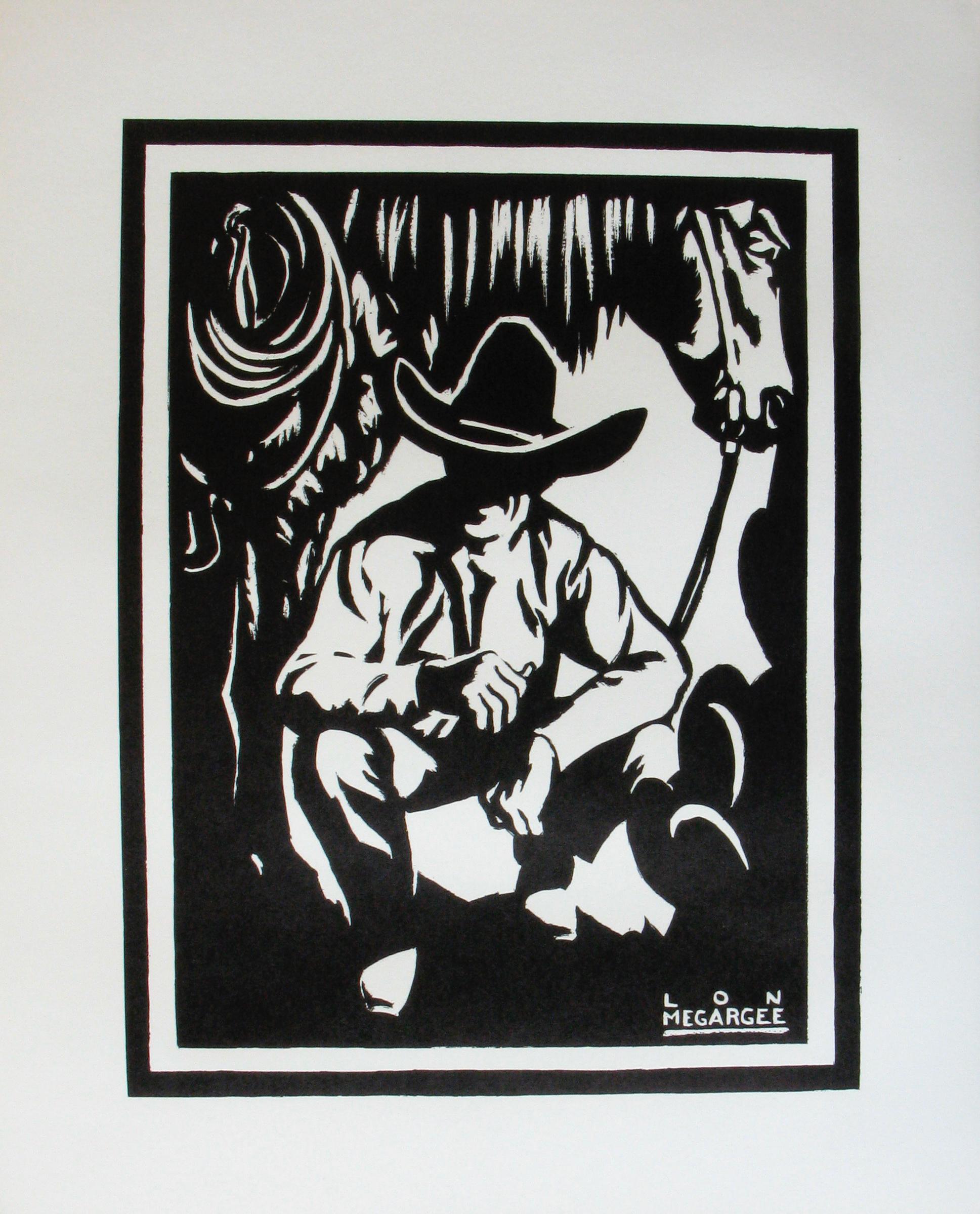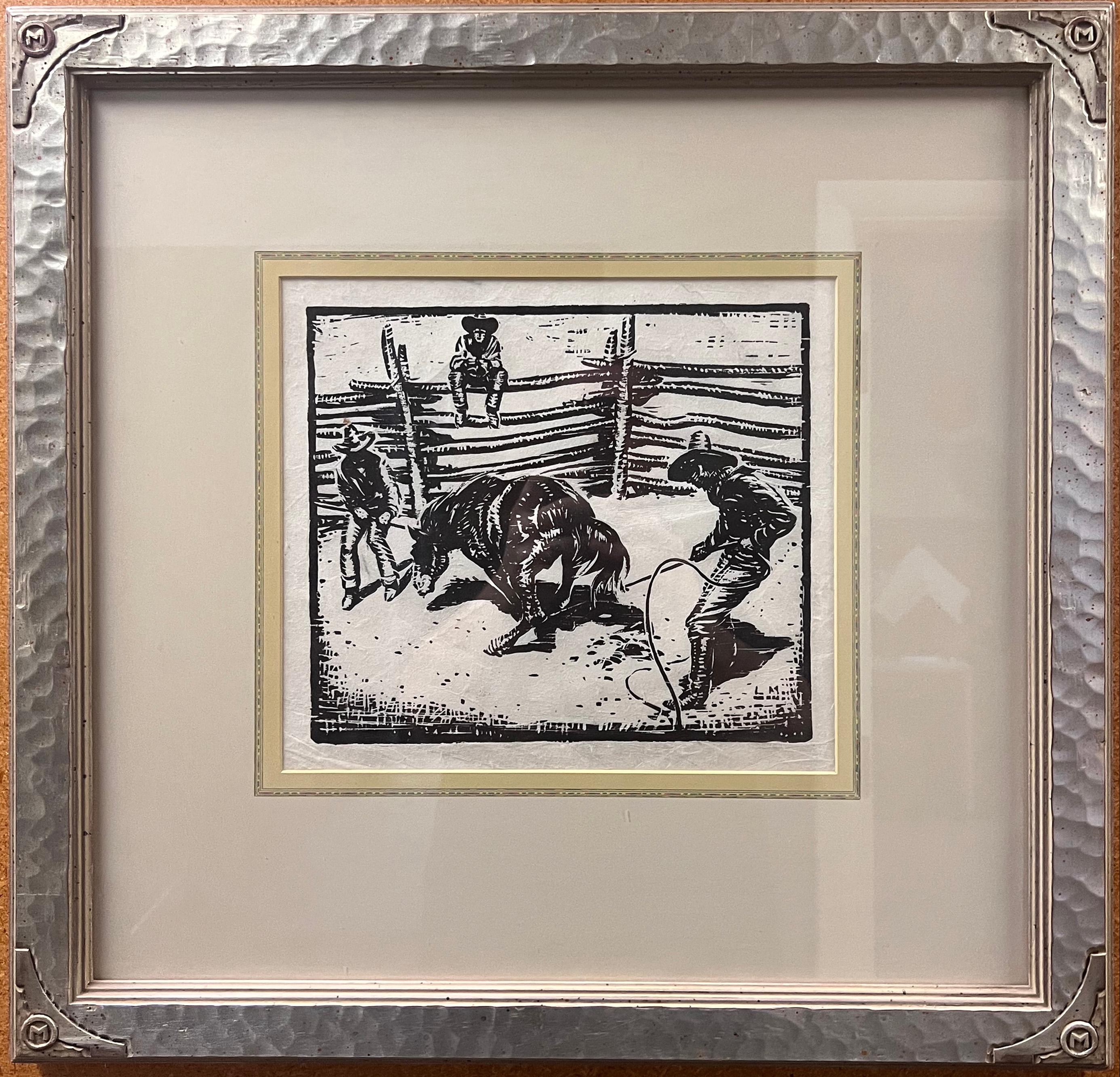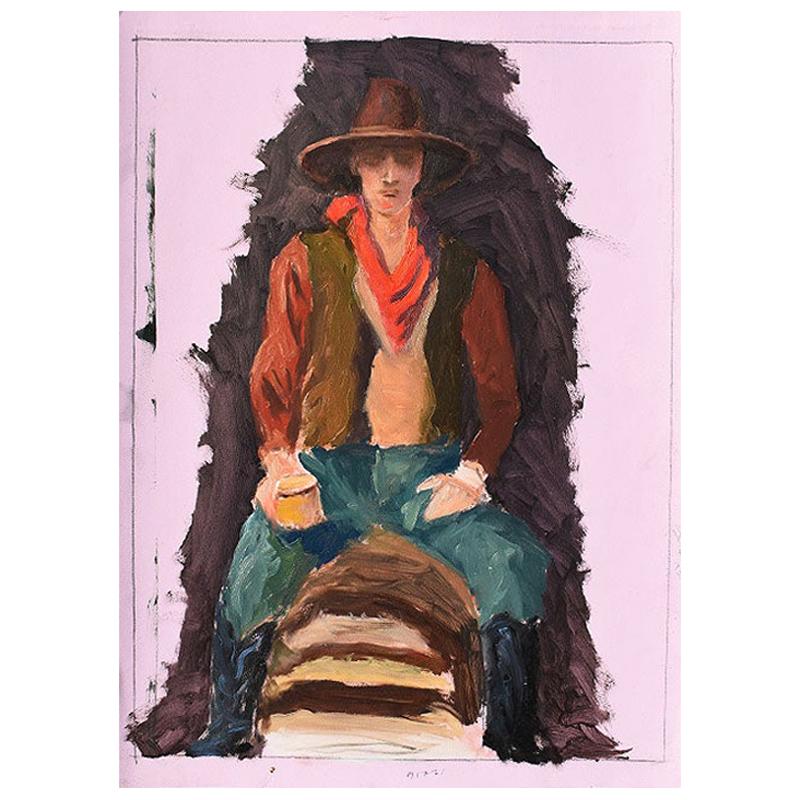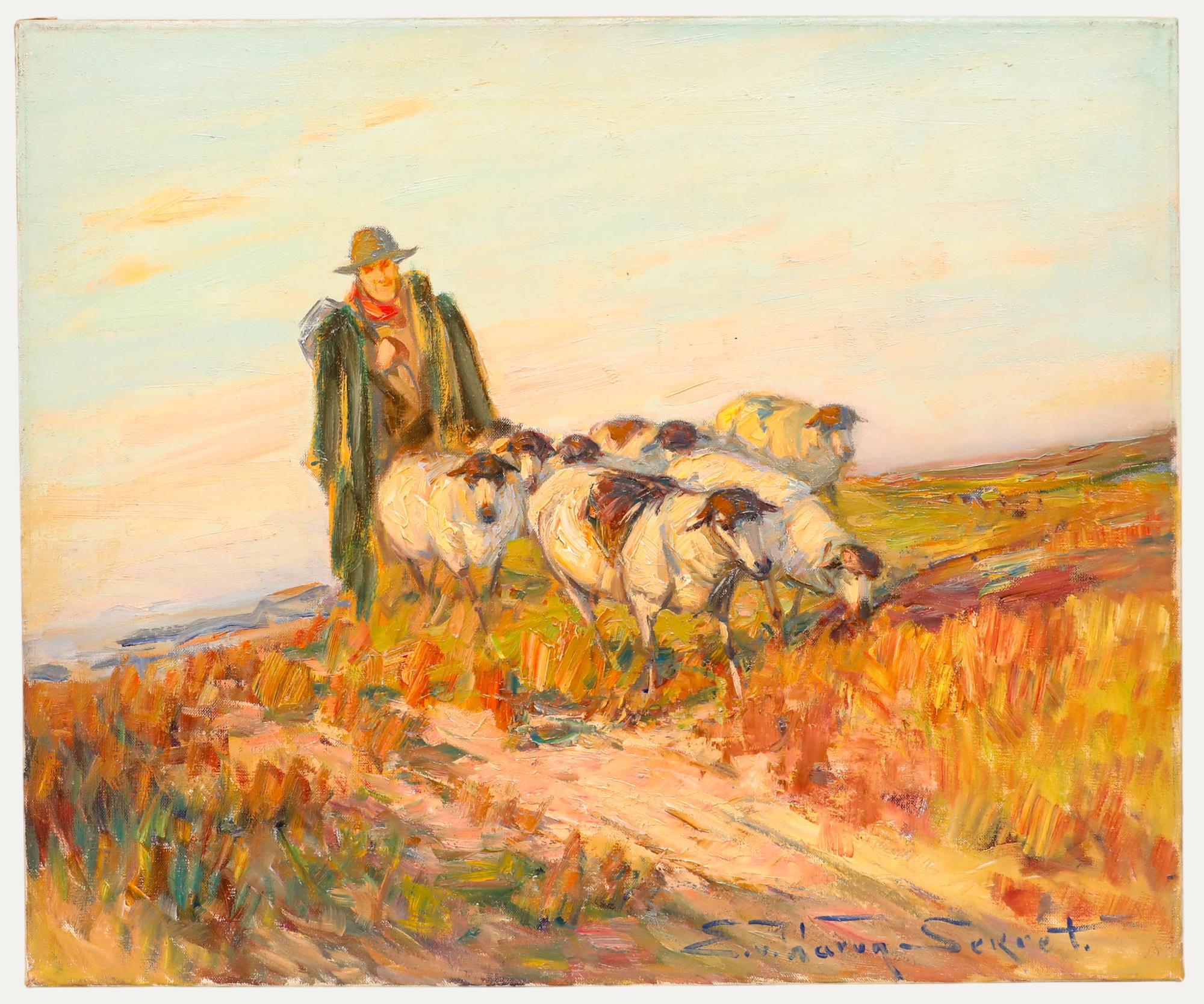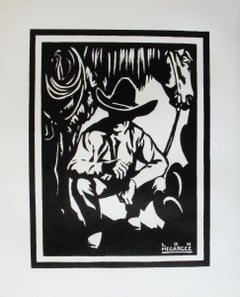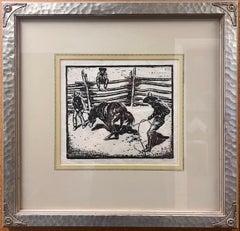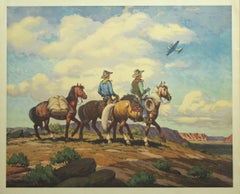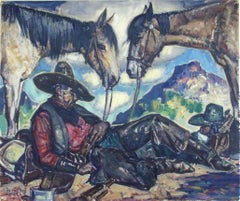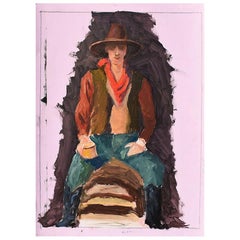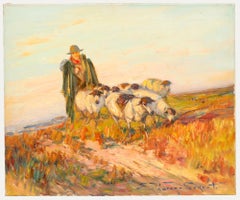Items Similar to The Sheepherder by Lon Megargee
Want more images or videos?
Request additional images or videos from the seller
1 of 7
Lon MegargeeThe Sheepherder by Lon Megargeeca. 1920s
ca. 1920s
$3,800
£2,892.75
€3,307.03
CA$5,346.65
A$5,848.36
CHF 3,079.32
MX$69,823.43
NOK 39,246.37
SEK 35,901.06
DKK 24,700.10
About the Item
Lon Megargee 1883-1960
"The Sheepherder"
Wood block print
Signed in plate, lower right
Image size: 10 x 10 inches
Frame size 22 x 22 inches
Creator of Stetson's hat logo "Last Drop from his Hat"
Lon Megargee
1883 - 1960
At age 13, Lon Megargee came to Phoenix in 1896 following the death of his father in Philadelphia. For several years he resided with relatives while working at an uncle’s dairy farm and at odd jobs. He returned to Philadelphia in 1898 – 1899 in order to attend drawing classes at the Pennsylvania Academy of the Fine Arts. Back in Phoenix in 1899, he decided at the age of 16 to try to make his living as a cowboy.
Lon moved to the cow country of Wickenburg, Arizona where he was hired by Tex Singleton’s Bull Ranch. He later joined the Three Bar R. . . and after a few years, was offered a job by Billy Cook of the T.T. Ranch near New River. By 1906, Megargee had learned his trade well enough to be made foreman of Cook’s outfit.
Never shy about taking risks, Lon soon left Cook to try his own hand at ranching. He partnered with a cowpuncher buddy, Tom Cavness, to start the El Rancho Cinco Uno at New River. Unfortunately, the young partners could not foresee a three-year drought that would parch Arizona, costing them their stock and then their hard-earned ranch.
Breaking with his romantic vision of cowboy life, Megargee finally turned to art full time. He again enrolled at the Pennsylvania Academy of Art and then the Los Angeles School of Art and Design during 1909 – 1910. The now well-trained student took his first trip to paint “en plein air” (outdoors) to the land of Hopi and Navajo peoples in northern Arizona. After entering paintings from this trip in the annual Territorial Fair at Phoenix, in 1911, he surprisingly sold his first oil painting to a major enterprise – the Santa Fe Railroad . . . Lon received $50 for “Navajos Watching the Santa Fe Train.” He soon sold the SFRR ten paintings over the next two years. For forty years the railroad was his most important client, purchasing its last painting from him in 1953.
In a major stroke of good fortune during his early plein-air period, Megargee had the opportunity to paint with premier artist, William R. Leigh (1866 – 1955). Leigh furnished needed tutoring and counseling, and his bright, impressionistic palette served to enhance the junior artist’s sense of color and paint application. In a remarkable display of unabashed confidence and personable salesmanship, Lon Megargee, at age 30, forever linked his name with Arizona art history. Despite the possibility of competition from better known and more senior artists, he persuaded Governor George Hunt and the Legislature in 1913 to approve 15 large, historic and iconic murals for the State Capitol Building in Phoenix. After completing the murals in 1914, he was paid the then princely sum of roughly $4000. His Arizona statehood commission would launch Lon to considerable prominence at a very early point in his art career.
Following a few years of art schooling in Los Angeles, and several stints as an art director with movie studios, including Paramount, Megargee turned in part to cover illustrations for popular Western story magazines in the 1920s.
In the 1920s, as well, Lon began making black and white prints of Western types and of genre scenes from woodblocks. These prints he generally signed and sold singly. In 1933, he published a limited edition, signed and hard-cover book (about 250 copies and today rare)containing a group of 28 woodblock images. Titled “The Cowboy Builds a Loop,” the prints are noteworthy for strong design, excellent draftsmanship, humanistic and narrative content, and quality. Subjects include Southwest Indians and cowboys, Hispanic men and women, cattle, horses, burros, pioneers, trappers, sheepherders, horse traders, squaw men and ranch polo players. Megargee had a very advanced design sense for simplicity and boldness which he demonstrated in how he used line and form. His strengths included outstanding gestural (action) art and strong figurative work. He was superb in design, originality and drawing, as a study of his prints in the Hays collection reveals.
In 1944, he published a second group of Western prints under the same title as the first. Reduced to 16 images from the original 28 subjects, and slightly smaller, Lon produced these prints in brown ink on a heavy, cream-colored stock. He designed a sturdy cardboard folio to hold each set. For the remainder of his life, Lon had success selling these portfolios to museum stores, art fairs and shows, and to the few galleries then selling Western art.
Drawing on real working and life experiences, Lon Megargee had a comprehensive knowledge, understanding and sensitivity for Southwestern subject matter. Noted American modernist, Lew Davis (1910 – 1979), helped to explain the uniqueness, strength and character of Megargee’s art in a 1975 interview with an Arizona publication: “His restless independence as a man and an artist was clear then (before WWI) and remained so until his death. Always one characteristic stood out. He was indigenous. He belonged here. Not a carpetbagger with a paint box, or a disillusioned urbanite seeking a new life, but an artist who used what he knew and had lived to put down what he had seen.”
From the origins of his career in art, Lon Megargee had a strong sense of the importance and worthiness of contributions that had been made by Native Americans and Hispanics. Even when satirizing their actions and foibles, and those of his Anglo peers, Megargee in his art provided a fairness and balance to all creeds that was enlightened for its time.” Credit: Abe Hays
- Creator:Lon Megargee (1883 - 1960, American)
- Creation Year:ca. 1920s
- Dimensions:Height: 10 in (25.4 cm)Width: 10 in (25.4 cm)
- Medium:
- Movement & Style:
- Period:
- Condition:Signature Megargee Circle M logo frame, hand carved with gilded metal leaf. Conservation framing, UV glass. Custom French lines with hand dyed color panel, hand applied. Frame size, 22 x 22 inches. Creator of Stetson's logo "Last Drop from his Hat".
- Gallery Location:Phoenix, AZ
- Reference Number:1stDibs: LU2623212833712
About the Seller
No Reviews Yet
Vetted Professional Seller
Every seller passes strict standards for authenticity and reliability
1stDibs seller since 2023
8 sales on 1stDibs
- ShippingRetrieving quote...Shipping from: Phoenix, AZ
- Return Policy
More From This Seller
View AllLonghorns by Lon Megargee
Located in Phoenix, AZ
Lon Megargee 1883-1960
"Self Portrait"
Wood block print
Signed in plate, lower right
Image size: 15.63 x 12 inches
Frame size xx x xx inches
Creator of S...
Category
1930s American Impressionist Animal Prints
Materials
Screen
The Bronc by Lon Megargee
Located in Phoenix, AZ
Lon Megargee 1883-1960
"The Bronc"
Wood block print
Signed in plate, lower right
Image size: 9 x 10 inches
Frame size 21 x 21.5 inches
Creator of Stetson's hat logo "Last Drop from his Hat"
Lon Megargee
1883 - 1960
At age 13, Lon Megargee came to Phoenix in 1896 following the death of his father in Philadelphia. For several years he resided with relatives while working at an uncle’s dairy farm and at odd jobs. He returned to Philadelphia in 1898 – 1899 in order to attend drawing classes at the Pennsylvania Academy of the Fine Arts. Back in Phoenix in 1899, he decided at the age of 16 to try to make his living as a cowboy.
Lon moved to the cow country of Wickenburg, Arizona where he was hired by Tex Singleton’s Bull Ranch. He later joined the Three Bar R. . . and after a few years, was offered a job by Billy Cook of the T.T. Ranch near New River. By 1906, Megargee had learned his trade well enough to be made foreman of Cook’s outfit.
Never shy about taking risks, Lon soon left Cook to try his own hand at ranching. He partnered with a cowpuncher buddy, Tom Cavness, to start the El Rancho Cinco Uno at New River. Unfortunately, the young partners could not foresee a three-year drought that would parch Arizona, costing them their stock and then their hard-earned ranch.
Breaking with his romantic vision of cowboy life, Megargee finally turned to art full time. He again enrolled at the Pennsylvania Academy of Art and then the Los Angeles School of Art and Design during 1909 – 1910. The now well-trained student took his first trip to paint “en plein air” (outdoors) to the land of Hopi and Navajo peoples in northern Arizona. After entering paintings from this trip in the annual Territorial Fair at Phoenix, in 1911, he surprisingly sold his first oil painting to a major enterprise – the Santa Fe Railroad . . . Lon received $50 for “Navajos Watching the Santa Fe Train.” He soon sold the SFRR ten paintings over the next two years. For forty years the railroad was his most important client, purchasing its last painting from him in 1953.
In a major stroke of good fortune during his early plein-air period, Megargee had the opportunity to paint with premier artist, William R. Leigh (1866 – 1955). Leigh furnished needed tutoring and counseling, and his bright, impressionistic palette served to enhance the junior artist’s sense of color and paint application. In a remarkable display of unabashed confidence and personable salesmanship, Lon Megargee, at age 30, forever linked his name with Arizona art history. Despite the possibility of competition from better known and more senior artists, he persuaded Governor George Hunt and the Legislature in 1913 to approve 15 large, historic and iconic murals for the State Capitol Building in Phoenix. After completing the murals in 1914, he was paid the then princely sum of roughly $4000. His Arizona statehood commission would launch Lon to considerable prominence at a very early point in his art career.
Following a few years of art schooling in Los Angeles, and several stints as an art director with movie studios, including Paramount, Megargee turned in part to cover illustrations for popular Western story magazines in the 1920s.
In the 1920s, as well, Lon began making black and white prints of Western types and of genre scenes from woodblocks. These prints he generally signed and sold singly. In 1933, he published a limited edition, signed and hard-cover book (about 250 copies and today rare)containing a group of 28 woodblock images. Titled “The Cowboy Builds a Loop,” the prints are noteworthy for strong design, excellent draftsmanship, humanistic and narrative content, and quality. Subjects include Southwest Indians and cowboys, Hispanic men and women, cattle, horses, burros, pioneers, trappers, sheepherders, horse traders, squaw men and ranch polo players. Megargee had a very advanced design sense for simplicity and boldness which he demonstrated in how he used line and form. His strengths included outstanding gestural (action) art and strong figurative work. He was superb in design, originality and drawing, as a study of his prints in the Hays collection reveals.
In 1944, he published a second group of Western prints under the same title as the first. Reduced to 16 images from the original 28 subjects, and slightly smaller, Lon produced these prints in brown ink on a heavy, cream-colored stock. He designed a sturdy cardboard folio to hold each set. For the remainder of his life, Lon had success selling these portfolios to museum stores, art fairs and shows, and to the few galleries then selling Western art.
Drawing on real working and life experiences, Lon Megargee had a comprehensive knowledge, understanding and sensitivity for Southwestern subject matter. Noted American modernist, Lew Davis...
Category
Early 20th Century American Impressionist Figurative Prints
Materials
Woodcut
Bomber and Buckeroos by Till Goodan, Westward Ho Company
Located in Phoenix, AZ
Bomber And Buckeroos ca. 1939
Till Goodan
Offset Lithograph
PRINTS ARE IN GOOD CONDITION. PRINTS MAY HAVE SMALL FLAW ALONG EDGE OF PAPER, DOES NOT EFFECT THE PRINT IMAGE
All the prints are 26 x 31 inches, Mustang Peeler, Bombers and Buckaroos, The stranger, Guardians of the Range and Range Baby.
Note that “The Mustang Runner” is 3 inches shorter in height, 23 x 31 inches
The print by Till Goodan was originally a painting and reproduced by the Westward Ho company as a set. Westward Ho produced the most sought after Western dinnerware ever made. The most popular pattern was the Rodeo pattern by Till Goodan. He Illustrated and branded many accessories sold by the Westward Ho Company.
Tillman Parker Goodan 1896-1958
To the casual observer his paintings are exciting and colorful. To the scholars of the Western Era they are benchmarks of authenticity. Such is the style of Till Goodan. He was born Tillman Parker Goodan in Eaton, Colorado on March 27, 1896. His father was a true western pioneer, mayor of Eaton, publisher of its first newspaper, and County Commissioner for several years.
After moving to California in 1905 and settling on a little farm that bordered the Michel Cattle Ranch, Till spent much of his boyhood with the Michel sons working on their ranch. There he developed his expertise as a calf roper and the skills of a working cowboy.
As a young man Till pursued endeavors that would initially callous his emerging artistic hands. He worked for the famous Miller and Lux Ranch in California. He packed mules and ran pack trains into the Sierra Mountains. He broke horses and competed in local rodeos riding saddle broncs and roping calves. And during the quiet hours he would draw pictures of ranch life and the action of the rodeo. People began commenting on his talents as an artist.
In 1917 he left the rodeo circuit and turned his full attention to a career in art. He studied with Roger Sterrett, William Paxton, and Dana Bartlett, all highly respected California artists. Till soon became a free-lance commercial artist doing work for Grauman’s Chinese and Lowe’s Theaters, Helms Bakery and Security Bank. He later assumed a position as Art Director for the Richfield Oil Company. However, his first love was still the art of the old west, horses, cowboys, and ranching. So, he left Richfield and gave his full attention to the field of fine arts.
He did oil painting, water colors and lithographs. He drew the Gene Autry Comic Books. He illustrated and hand lettered a large collection of stories about famous bucking horses, ranches, horsemen of the world, and western gear. In association with W.C. Wentz, he started producing a complete line of western gift wares, ceramics, bronzes, leather, paper, and fabric.
By the 1930′s he was beginning to receive recognition for his western art and by the early 1940s, he and his daughter, Betty, were illustrating comic books for his longtime friend, Gene Autry. Betty was also a world champion cowgirl.
Till Goodan designs appeared in virtually every medium. But, the most famous was the four lines of dinnerware produced by Wallace China...
Category
1930s American Impressionist Figurative Prints
Materials
Lithograph
Siesta by Lon Megargee 1929, Archival Pigmrnt Print
Located in Phoenix, AZ
Tequila Siesta
Lon Megargee
Archival Pigment Print
100% 300 gram cotton rag paper
Size: 22.5 x 27 inches
Paper size: 24 x 28.5 inches
Creator of the iconic logo for the Stetson Hat Company, " Last Drop From his Stetson", still in use today.
Fine Art Estate of Lon Megargee
At age 13, Lon Megargee came to Phoenix in 1896 following the death of his father in Philadelphia. For several years he resided with relatives while working at an uncle’s dairy farm and at odd jobs. He returned to Philadelphia in 1898 – 1899 in order to attend drawing classes at the Pennsylvania Academy of the Fine Arts. Back in Phoenix in 1899, he decided at the age of 16 to try to make his living as a cowboy. Lon moved to the cow country of Wickenburg where he was hired by Tex Singleton’s Bull Ranch. He later joined the Three Bar Ranch . . . and, after a few years, was offered a job by Billy Cook...
Category
1920s Figurative Prints
Materials
Archival Pigment
Hopi by Lon Megargee, Original Signed Block Print ca. 1920s
Located in Phoenix, AZ
Title: Hopi ca. 1920s
Artist: Lon Megargee
Medium: Block Print
Size: 11 x 11 inches (Sight Measurement)
SHIPPING CHARGES INCLUDE SHIPPING, PACKAGING & INSURANCE
Creator of Stetson's hat logo "Last Drop from his Hat"
Image of Lon Megargee not included in purchase.
Lon Megargee
1883 - 1960
At age 13, Lon Megargee came to Phoenix in 1896 following the death of his father in Philadelphia. For several years he resided with relatives while working at an uncle’s dairy farm and at odd jobs. He returned to Philadelphia in 1898 – 1899 in order to attend drawing classes at the Pennsylvania Academy of the Fine Arts. Back in Phoenix in 1899, he decided at the age of 16 to try to make his living as a cowboy.
Lon moved to the cow country of Wickenburg, Arizona where he was hired by Tex Singleton’s Bull Ranch. He later joined the Three Bar R. . . and after a few years, was offered a job by Billy Cook of the T.T. Ranch near New River. By 1906, Megargee had learned his trade well enough to be made foreman of Cook’s outfit.
Never shy about taking risks, Lon soon left Cook to try his own hand at ranching. He partnered with a cowpuncher buddy, Tom Cavness, to start the El Rancho Cinco Uno at New River. Unfortunately, the young partners could not foresee a three-year drought that would parch Arizona, costing them their stock and then their hard-earned ranch.
Breaking with his romantic vision of cowboy life, Megargee finally turned to art full time. He again enrolled at the Pennsylvania Academy of Art and then the Los Angeles School of Art and Design during 1909 – 1910. The now well-trained student took his first trip to paint “en plein air” (outdoors) to the land of Hopi and Navajo peoples in northern Arizona. After entering paintings from this trip in the annual Territorial Fair at Phoenix, in 1911, he surprisingly sold his first oil painting to a major enterprise – the Santa Fe Railroad . . . Lon received $50 for “Navajos Watching the Santa Fe Train.” He soon sold the SFRR ten paintings over the next two years. For forty years the railroad was his most important client, purchasing its last painting from him in 1953.
In a major stroke of good fortune during his early plein-air period, Megargee had the opportunity to paint with premier artist, William R. Leigh (1866 – 1955). Leigh furnished needed tutoring and counseling, and his bright, impressionistic palette served to enhance the junior artist’s sense of color and paint application. In a remarkable display of unabashed confidence and personable salesmanship, Lon Megargee, at age 30, forever linked his name with Arizona art history. Despite the possibility of competition from better known and more senior artists, he persuaded Governor George Hunt and the Legislature in 1913 to approve 15 large, historic and iconic murals for the State Capitol Building in Phoenix. After completing the murals in 1914, he was paid the then princely sum of roughly $4000. His Arizona statehood commission would launch Lon to considerable prominence at a very early point in his art career.
Following a few years of art schooling in Los Angeles, and several stints as an art director with movie studios, including Paramount, Megargee turned in part to cover illustrations for popular Western story magazines in the 1920s.
In the 1920s, as well, Lon began making black and white prints of Western types and of genre scenes from woodblocks. These prints he generally signed and sold singly. In 1933, he published a limited edition, signed and hard-cover book (about 250 copies and today rare)containing a group of 28 woodblock images. Titled “The Cowboy Builds a Loop,” the prints are noteworthy for strong design, excellent draftsmanship, humanistic and narrative content, and quality. Subjects include Southwest Indians and cowboys, Hispanic men and women, cattle, horses, burros, pioneers, trappers, sheepherders, horse traders, squaw men and ranch polo players. Megargee had a very advanced design sense for simplicity and boldness which he demonstrated in how he used line and form. His strengths included outstanding gestural (action) art and strong figurative work. He was superb in design, originality and drawing, as a study of his prints in the Hays collection reveals.
In 1944, he published a second group of Western prints under the same title as the first. Reduced to 16 images from the original 28 subjects, and slightly smaller, Lon produced these prints in brown ink on a heavy, cream-colored stock. He designed a sturdy cardboard folio to hold each set. For the remainder of his life, Lon had success selling these portfolios to museum stores, art fairs and shows, and to the few galleries then selling Western art.
Drawing on real working and life experiences, Lon Megargee had a comprehensive knowledge, understanding and sensitivity for Southwestern subject matter. Noted American modernist, Lew Davis...
Category
1920s American Impressionist Figurative Prints
Materials
Woodcut
High Wide and Handsome by Fletcher Martin 1953, Original Stone Lithograph
By Fletcher Martin
Located in Phoenix, AZ
SHIPPING CHARGES INCLUDE SHIPPING, PACKAGING & **INSURANCE**
Fletcher Martin
Size: 16 x12 inches
Stone lithograph
Frame 25 x 21 inches
High, Wide and Handsome- - 1953, Lithograph....
Category
1950s Contemporary Figurative Prints
Materials
Lithograph
You May Also Like
Navajo Weaver
By Conrad Buff
Located in San Francisco, CA
This artwork titled "Navajo Weaver" 1937, is an original color lithograph on paper by noted Swiss/American artist Conrad Buff, 1886-1975. It is hand signed in pencil by the artist, t...
Category
Mid-20th Century American Impressionist Figurative Prints
Materials
Lithograph
Clair Seglem Original Portrait Painting of a Cowboy
Located in Oklahoma City, OK
This lovely portrait painting depicts a cowboy sitting upon a stool. He wears blue jeans, black cowboy boots, a brown vest, a western cowboy hat, and a red vest. With fabulous texture and moody colors, the artist captures the portrait of the quintessential Oklahoma cowboy.
This work of art is unframed and ready for framing. We are happy to coordinate framing for you for an additional cost.
This piece is by the late Oklahoma artist and retired Air Force man Clair Seglem...
Category
20th Century American Country Paintings
Materials
Paint, Paper
$975 Sale Price
25% Off
Eugen Von Warun-Sekret (1896-1963) - Oil, A Shepherd with his Flock
Located in Corsham, GB
Eugen Von Warun-Sekret (1896-1963) Original, oil on canvas. Pastoral landscape with a shepherd guiding his flock at sunset. Signed lower right.
Category
Mid-20th Century Landscape Paintings
Materials
Oil
"Boots Mansfield Calf Roping" Tie- Down Roping World Champion
Located in San Antonio, TX
Pepper Brown
(1926-1999)
Alpine Artist
Image Size: 9.5 x 9.25
Frame Size: 15.5 x 19
Medium: Ink Drawing
Dated 1942
"Boots Mansfield Calf Roping" Tie- Dow...
Category
1940s Impressionist Animal Drawings and Watercolors
Materials
Ink
"Down By The Rio Grande" Texas Cowboy Western Dallas Artist Fred Darge 1900-1978
Located in San Antonio, TX
Fred Darge (1900-1978) Dallas Image Size: 24 x 30 Frame Size: 32 x 38 Medium: Oil, "Down By The Rio Grande"
Biography
Fred Darge (1900-1978)
Friedrich Ernst Darge Born: March 1 1900 Rendsburg, Germany Died: April 10 1978 Dallas, Texas Entered the U.S. ; Jan. 14 1923 at Port Arthur, Texas. By 1924 he was in Chicago painting under the W.P.A. Artists policy and attending the Art Institute of Chicago from where he graduated. While in Chicago he painted and made model sail boats...
Category
1940s Impressionist Landscape Paintings
Materials
Oil
"Roy Matthews Calf Roping" Famous 1930s/40s Rodeo Rider
Located in San Antonio, TX
Pepper Brown
(1926-1999)
Alpine Artist
Image Size: 9 x 13
Frame Size: 15 x 18.75
Medium: Ink Drawing
Dated 1942
"Roy Matthews Calf Roping"
Category
1940s Impressionist Animal Drawings and Watercolors
Materials
Ink
